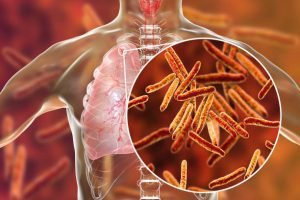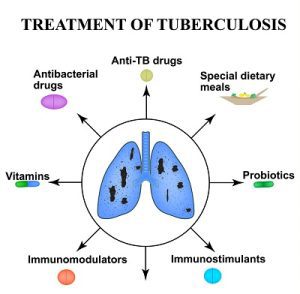
As a bacterial infection, tuberculosis (TB) usually affects the lungs, although it can also affect other body parts. It is spread by airborne droplets when bacteria multiply. TB is usually preventable and treatable, but it can sometimes be fatal. Globally, consumption, or TB, was the leading cause of death in the past. Industrialized countries saw a dramatic reduction in TB incidence after improving living conditions and developing antibiotics.The World Health Organization estimates that by 2020, nearly 10 million people will have TB, and 1.5 million will die, including 214,000 HIV-positive people. There is renewed concern among experts about TB due to antibiotic resistance. Treatment for TB is complex in this case. Most effective treatments do not seem to be effective for some disease strains.
Tuberculosis: Causes, Symptoms, Diagnosis, Treatment.
The most common way to contract TB is by inhaling Mycobacterium tuberculosis (M. tuberculosis) bacteria. A person usually only becomes sick from TB that affects the lungs after having close contact with someone who has this form of TB. In 1931, the Pasteur Institute in Paris, France, developed a tuberculosis vaccine called BCG (Bacillus Calmette-Guerin).
What is tuberculosis? Infection with TB (latent TB)
A TB bacteria can be present in an individual’s body without causing symptoms. The person will be infected with TB but will not have active disease. Bacteria can usually be contained in people by their immune systems, so they do not multiply and cause illness.
Active (TB)
TB bacteria may not be able to survive in the body. Typically, this occurs when there is a weakened immune system due to illness or medication use. TB symptoms result from bacteria reproducing and replicating, causing infection. Those with active infection spread TB.
Signs and symptoms
TB latent: People with latent TB don’t show symptoms, and chest X-rays don’t reveal any damage. Infection with TB can be detected by a skin prick test or a blood test. Individuals with active TB can experience a persistent cough, phlegm, fatigue, fever, chills, and a loss of appetite and weight. The disease typically worsens over time, but symptoms can disappear and reappear spontaneously.


Signs of early warning
If you are experiencing any of these symptoms, you should consult a doctor;
- Cough that persists for three weeks or more
- Coughing may produce phlegm that contains blood
- Weight loss and loss of appetite
- Fatigue and feeling unwell are common symptoms
- The neck is swollen
- Feeling feverish
- Sweaty nights
- Having chest pains
In addition to the lungs
TB There are times when symptoms can appear in other areas of the body besides the lungs. A weakened immune system makes this more likely to occur.
TB can cause the following symptoms:
- “Swollen glands,” or persistently swollen lymph nodes
- The stomach hurts
- Pain in the joints or bones
- Confusion
- Chronic headaches
- A seizure
When Seeing a doctor is necessary?
If you suspect you have been exposed to TB, see your doctor. Consult your doctor if you have a fever, unexplained weight loss, persistent cough, drenching night sweats, or unexplained weight gain. These are signs of TB often, but they can also be symptoms of other conditions. According to the Centers for Disease Control and Prevention, people with an elevated risk of tuberculosis should be tested for latent tuberculosis.
The following people are recommended:
- Infected with HIV/AIDS
- Utilize intravenous medications
- Contacts infected individuals
- Have lived in a country where TB is common, such as some Latin American, African, and Asian countries
- If you live or work in an area where TB is prevalent, such as a prison or nursing home, you’re at risk
- Treat high-risk patients in health care
- TB is a risk to children exposed to adults
Causes
A tuberculosis bacterium spreads from person to person by dropping microscopic droplets into the air. Those with untreated, active tuberculosis can experience this when they cough, speak, sneeze, spit, laugh, or sing. Despite being contagious, tuberculosis is difficult to catch. Tuberculosis is more likely to spread among people you live with or work with than strangers. When active TB has been treated with appropriate drugs for at least two weeks, most patients are no longer contagiou HIV and TB
Since the AIDS epidemic began in the 1980s, the number of tuberculosis cases has risen dramatically. The body cannot control TB bacteria when HIV suppresses the immune system. Because of this, people with HIV can develop latent and active TB much more quickly than people who do not have HIV.
Drug-resistant TB
The increase in drug-resistant strains of tuberculosis also contributes to its death toll. Some TB germs have become resistant to medications over time. A part of the problem stems from people not following instructions or not completing treatment.
Complications
Tuberculosis is fatal without treatment. The active disease tends to affect the lungs, but other body parts can also be affected.
The following complications may occur as a result of tuberculosis:
- Pain in the spine. A common complication of tuberculosis is back pain and stiffness.
- Damage to the joints. The hips and knees are usually affected by tuberculous arthritis (tuberculous arthritis).
- Membranes covering the brain swell (meningitis). The condition can cause lasting or intermittent headaches that last for weeks or cause mental changes.
- Problems with the liver or kidneys. Waste and impurities are filtered from your bloodstream by your liver and kidneys. They can be damaged by tuberculosis if they are infected.
- Cardiovascular diseases. There is a rare possibility that tuberculosis could infect your heart’s tissues, causing inflammation and fluid accumulations that might hinder your heart’s pumping ability. Tamponade of the heart, also known as cardiac arrest, is a potentially fatal condition.
Prevention
To reduce your risk of developing active tuberculosis, your doctor may prescribe you medications if you test positive for latent TB infection. The disease is only contagious if it is active.
How is tuberculosis diagnosed?
Screening for TB includes two types of tests: the Mantoux tuberculin skin test (TST) and the blood test called the interferon-gamma release assay (IGRA). You will receive a small injection of a substance called purified protein derivative (PPD) under the skin of your forearm for the TST. The healthcare provider should examine the injection site two to three days afterward. Blood samples are taken by a healthcare provider and sent to a laboratory for testing.
Additional tests to determine if your lungs are infecte or if an infection is an active include:
- A sputum sample and a lung fluid sample.
- An X-ray of the chest was taken.
- CT scans (computed tomography).
When should I get tested for tuberculosis?
You should get test for TB if:
- You are expose as a resident or employee of a facility where the risk is higher, such as a jail, hospice, skilled nursing facility, shelter, or another healthcare facility.
- A mycobacteriology laboratory is where you work.
- Someone you know or suspect of having TB disease has been in contact with you.
- As a result of a weak immune system, your body is susceptible to illness.
- You have symptoms of TB disease and suspect you already have it.
- You’re likely from a region or lived in one prone to TB outbreaks, such as Latin America, the Caribbean, Africa, Asia, Eastern Europe, and Russia.
- You have injected recreational drugs.
- Your healthcare provider recommends testing.
TREATMENT AND MANAGEMENT
What is the treatment for tuberculosis?


These drugs are use to treat TB infection and disease:
- The drug isoniazid (Hyzyd®).
- It is also known as Rifatin (Rifadin®).
- Myambutol® (Ethambutol).
- (Zinamide®) Pyrazinamide.
- Priftin® (Rifapentine).
The prescribed medication must be taken entirely, or all of the bacteria may not be wiped out. You’ll need to take the medication for as long as your doctor tells you to – sometimes up to nine months. TB has become drug resistant in some cases. Be sure to finish your prescription. Treatment for TB may involve more than one drug, which is extremely important and likely.
Treatment side effects and complications
Among the side effects associated with TB treatment are:
- Reactions such as skin rashes.
- Feeling nauseous and upset in the stomach.
- The skin is itchy.
- The skin and eyes become yellow (jaundice).
- The urine is dark.
Conclusion
However, in this blog, we had discussed all the details regarding Tuberculosis: Causes, Symptoms, Diagnosis, and Treatment. Hence, Consult – Dr. Virendra Singh if you experience any side effects because delaying may cause your liver and lungs damage.



